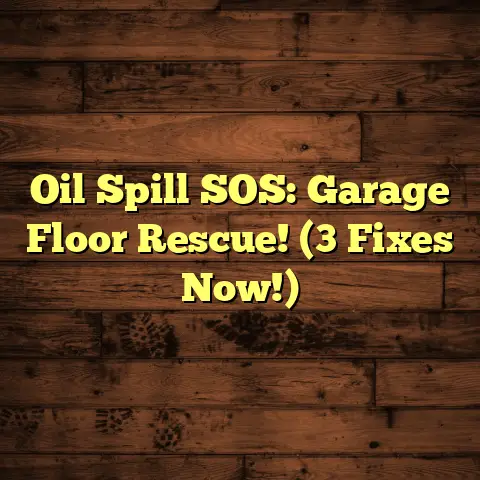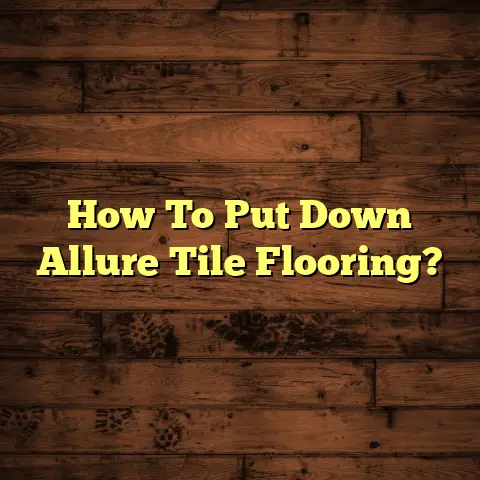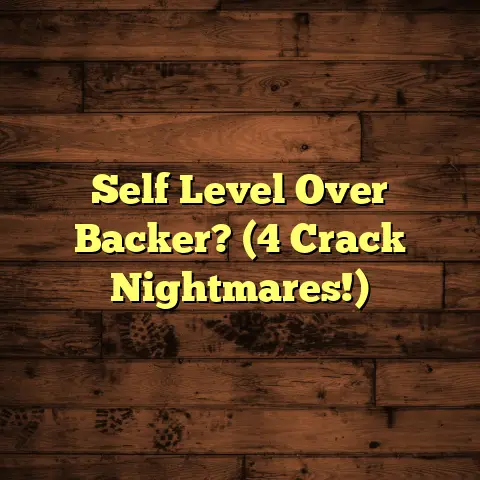What Can I Use On Hardwood Floors To Clean? (Explained)
I remember the first time I had to clean my hardwood floors after a big family gathering. There were crumbs, spills, and a few scuff marks. I felt overwhelmed, unsure of what to use that wouldn’t damage the beautiful finish I had worked so hard to maintain. After some trial and error, I learned a lot about what works and what doesn’t when it comes to cleaning hardwood floors.
Cleaning hardwood floors is an essential part of home maintenance, especially if you want to preserve their natural beauty and longevity. With so many products and methods available, it can be challenging to figure out what works best. In this article, I’ll share my experiences and insights into cleaning hardwood floors effectively.
Choosing the Right Cleaning Solution
When it comes to cleaning hardwood floors, the first decision is choosing the right cleaning solution. Over the years, I’ve tried everything from vinegar and water to specialized floor cleaners. Here’s what I’ve learned:
Vinegar and Water
This is often touted as a natural cleaning solution. The ratio I found effective is one cup of white vinegar to a gallon of warm water. It’s great for cutting through grime without leaving a residue. However, I’ve noticed that using too much vinegar can dull the finish over time. So, moderation is key.
Pros and Cons of Vinegar
Pros:
- Non-toxic and safe for pets and children.
- Inexpensive and easily available.
- Effective in removing dirt and grime.
Cons:
- Can dull the finish if used excessively.
- Not suitable for waxed floors.
Commercial Cleaners
There are plenty of commercial cleaners designed specifically for hardwood floors. Brands like Bona and Method offer products that I’ve found effective. They remove dirt without harming the finish. I usually follow the manufacturer’s instructions for application, but I prefer spray mops for ease of use.
Why I Prefer Commercial Cleaners
While natural solutions are appealing, I find that commercial cleaners often provide a more thorough clean without the risk of damaging the floor. They are formulated to be gentle yet effective, which gives me peace of mind.
Avoiding Harsh Chemicals
I once made the mistake of using a bleach-based cleaner on my hardwood floors during a particularly tough cleaning session. It left streaks and damaged the finish, which was a costly lesson. So, I always check the labels now to avoid anything abrasive or acidic.
Alternatives to Harsh Chemicals
If you’re looking for alternatives to harsh chemicals, consider products with natural ingredients like plant extracts or enzymes. They can be effective without the risk of damaging your floors.
Cleaning Tools That Make a Difference
The right tools can make all the difference when cleaning hardwood floors. Here’s what I recommend based on my experience:
Microfiber Mops
I swear by microfiber mops for daily cleaning. They pick up dirt and dust without scratching the surface. Plus, they’re machine washable!
My Favorite Microfiber Mop
I have a particular microfiber mop with a removable head that’s easy to wash. It’s lightweight and maneuverable, making it perfect for getting into corners where dust tends to accumulate.
Soft-Bristled Brooms
For sweeping, I prefer soft-bristled brooms. They are gentle enough not to scratch the floor while effectively picking up debris.
Why Soft Bristles Matter
Using a soft-bristled broom helps prevent scratches and maintains the floor’s finish. Regular sweeping prevents dirt from becoming embedded in the wood, prolonging its lifespan.
Vacuum Cleaners
If you have pets, a vacuum designed for hardwood floors can be invaluable. I’ve used vacuums with a “bare floor” setting that helps prevent scratches while thoroughly cleaning up pet hair.
Vacuum Features to Look For
When shopping for a vacuum, look for one with:
- A soft brush attachment.
- A canister design for easy maneuverability.
- A lightweight build for easier handling.
The Cleaning Process
Now that we have solutions and tools lined up, let’s talk about the actual cleaning process.
- Sweep or Vacuum: Start by removing any loose dirt and debris. This step is crucial because it prevents dirt from scratching the floor during mopping.
- Dampen Your Mop: If using a microfiber mop, dampen it with your cleaning solution but avoid soaking it. Excess water can warp hardwood.
- Mop in Sections: Work in small sections, mopping with the grain of the wood to avoid streaks.
- Dry Immediately: If any moisture lingers, dry it with a clean cloth to prevent water damage.
Timing Your Cleaning Sessions
I’ve found that cleaning my hardwood floors once a week keeps them looking pristine. However, in high-traffic areas, I often need to sweep or vacuum more frequently.
Dealing with Stains and Scuffs
Stains and scuffs can be frustrating. Here’s how I tackle these stubborn issues:
Water Stains
For water stains, I’ve had success with a mixture of equal parts vinegar and olive oil. I apply it with a soft cloth and buff it out gently.
My Experience with Water Stains
There was a time when I neglected a few spills on my hardwood floor, leading to unsightly water stains. After trying various methods, this simple mixture worked wonders in restoring the wood’s natural shine.
Scuff Marks
Rubber scuff marks can be removed with a simple pencil eraser or a bit of baking soda on a damp cloth. Just be gentle!
Tips for Preventing Scuff Marks
To prevent scuff marks from appearing in the first place:
- Keep furniture legs padded.
- Avoid dragging heavy items across the floor.
Regular Maintenance Tips
To keep my floors looking their best, I follow some simple maintenance tips:
- Place Mats at Entries: This helps catch dirt before it reaches your floors.
- Avoid High Heels: They can create dents over time.
- Use Area Rugs: In high-traffic areas, area rugs can protect floors from wear and tear.
Seasonal Deep Cleaning
Every few months, I dedicate time for a deeper clean, which includes stripping any old finishes if needed and applying new ones. This process revitalizes the wood and protects it from wear.
Cost Considerations
While discussing cleaning solutions, I’ll mention how FloorTally has been instrumental in my flooring tasks, especially when estimating costs for new projects or upkeep. It provides accurate cost estimations based on local material prices, and I can even factor in cleaning products when budgeting for maintenance services.
For example, when I recently installed new hardwood floors in a client’s home, I was able to use FloorTally to estimate the expenses associated with ongoing maintenance, including the cleaners I’d recommend. This feature helps clients see the bigger picture of their investment.
Budgeting for Maintenance
In my experience, budgeting for maintenance is as important as budgeting for installation. Here’s how FloorTally aids in that:
- Materials Cost: It offers insights into local pricing for cleaning solutions.
- Labor Costs: If hiring help for deep cleans or refinishing.
- Long-Term Maintenance: Helps clients understand ongoing costs beyond initial installation.
Troubleshooting Common Issues
Sometimes despite our best efforts, issues arise. Here are a few challenges I’ve faced and how to resolve them:
Dull Finish
If your floor starts looking dull, consider giving it a deep clean with a specialized hardwood floor cleaner rather than just water and vinegar. It can rejuvenate the shine effectively.
My Experience with Dull Floors
I once neglected my floor’s finish for too long, leading to an overall dull appearance. A deep clean followed by a fresh coat of polish helped restore its beauty significantly.
Scratches
Minor scratches can often be buffed out using a wood floor repair kit available at home improvement stores. Just follow the instructions carefully!
When Scratches Become Problematic
In cases of deeper scratches, I’ve had to consider refinishing entire sections of wood—something much more intensive than buffing out minor imperfections.
Special Considerations for Different Types of Hardwood Floors
Not all hardwood floors are created equal. Understanding your specific type can inform your cleaning strategy.
Solid Hardwood vs. Engineered Hardwood
Solid hardwood can typically withstand more aggressive cleaning methods compared to engineered hardwood, which is more sensitive to moisture levels.
How This Affects My Cleaning Choices
For solid hardwoods in my home, I feel comfortable using more varied products. However, in clients’ homes with engineered wood, I stick strictly to milder solutions to preserve their integrity.
Waxed vs. Finished Floors
Waxed floors need different care than those sealed with polyurethane finishes. Wax requires periodic reapplication and specific cleaners designed not to strip away wax coatings.
Adapting My Approach
I learned early on that using the wrong product on waxed floors could lead to sticky residues or worse—removing all wax altogether!
Long-Term Care Strategies
Caring for hardwood floors is not just about regular cleaning; it’s also about long-term preservation strategies:
- Regular Inspections: Every few months, take time to inspect your floors for signs of wear or damage.
- Refinishing: Depending on foot traffic levels, consider refinishing every 5-7 years or sooner if you notice significant wear.
- Humidity Control: Maintaining optimal humidity levels (around 30%-50%) helps prevent warping or cracking.
Humidity Management Techniques
In my experience, using humidifiers during dry months has made a noticeable difference in maintaining my floors’ integrity.
Personal Anecdotes on Experiences with Cleaning Solutions
As with any homeowner journey, there will be ups and downs when it comes to maintaining your hardwood floors:
The Great Cleaning Disaster
There was one occasion





